LITE ON TECHNOLOGY NM100BB DIGITAL MEDIA PLAYER MODULE User Manual app HwGuide DM870 Core2
LITE-ON Technology Corp. DIGITAL MEDIA PLAYER MODULE app HwGuide DM870 Core2
Users Manual
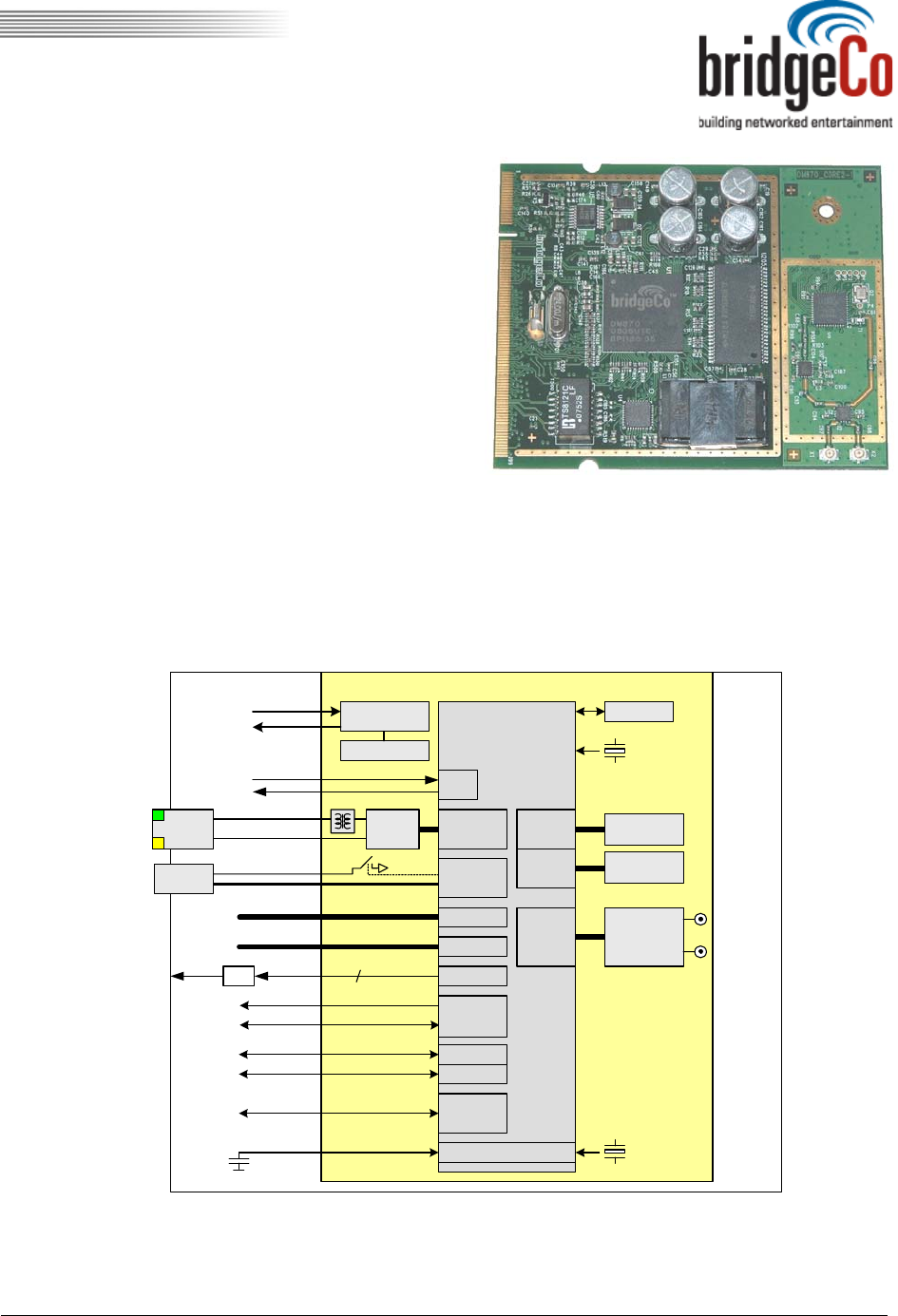
Hardware Guide DM870 Core-2
app_HwGuide_DM870-Core2.doc CONFIDENTIAL Version 1.2 – 04. Jun. 2008 page 1/5
BridgeCo AG – Ringstrasse 14 – CH-8600 Dübendorf – Tel: + 41 (44) 802 33 33 – Fax:+ 41 (44) 802 33 39 – info@bridgeco.net – www.bridgeco.com
Key features
• Complete system on a small module
• Standard SODIMM connector
• Integrated 802.11b/g + ethernet + USB2.0
• Glueless audio, video and control ports
• Single 5V supply
• Provides stabilized 3.3V
• WiFi certified (target)
• FCC certified (target)
Introduction
The DM870 Core-2 module is a single-board networked media player module, based on BridgeCo’s
DM870 media processor, and enables fast product developments with ethernet, WiFi and USB
connectivity. The module connects to standard legacy components in various audio, video/LCD and
control formats. It runs from a single 5V power supply and creates all the necessary voltages on the
module. A stabilized 3.3V power is provided to the main board, to allow for further system cost
reduction.
Block Diagram
Ethernet
PHY
DM870
256 Mbit
SDRAM
JTAG
RJ-45
100B-T
Mem
USB
GPIO
24.000 MHz
Reset In
NAND 1 GB
NAND flash
802.11
RF amp
802.11
RMII
SPI
RTC 32.768 kHz
USB
(Host)
USB
RST
UART
5V
Switcher 3V3
Switcher 1V2
5V
DM870 Core-2 Module
Reset Out
3.3V
Stereo Out
Video Out
Audio I/O
4bit MMC
3x6bit RGB
2 x UART
SPI Ctrl.
max. 20 GPIOs
3.3V (RTC)
SuperCap
IR sensor
reset signals
analog mute
I2C bus
shift register
IC control
serial control
A/D, D/A
S/PDIF
CCIR-656
LP 2
HP out
Display
SD-Card
AV
Ports
LCD
SSM
DAC
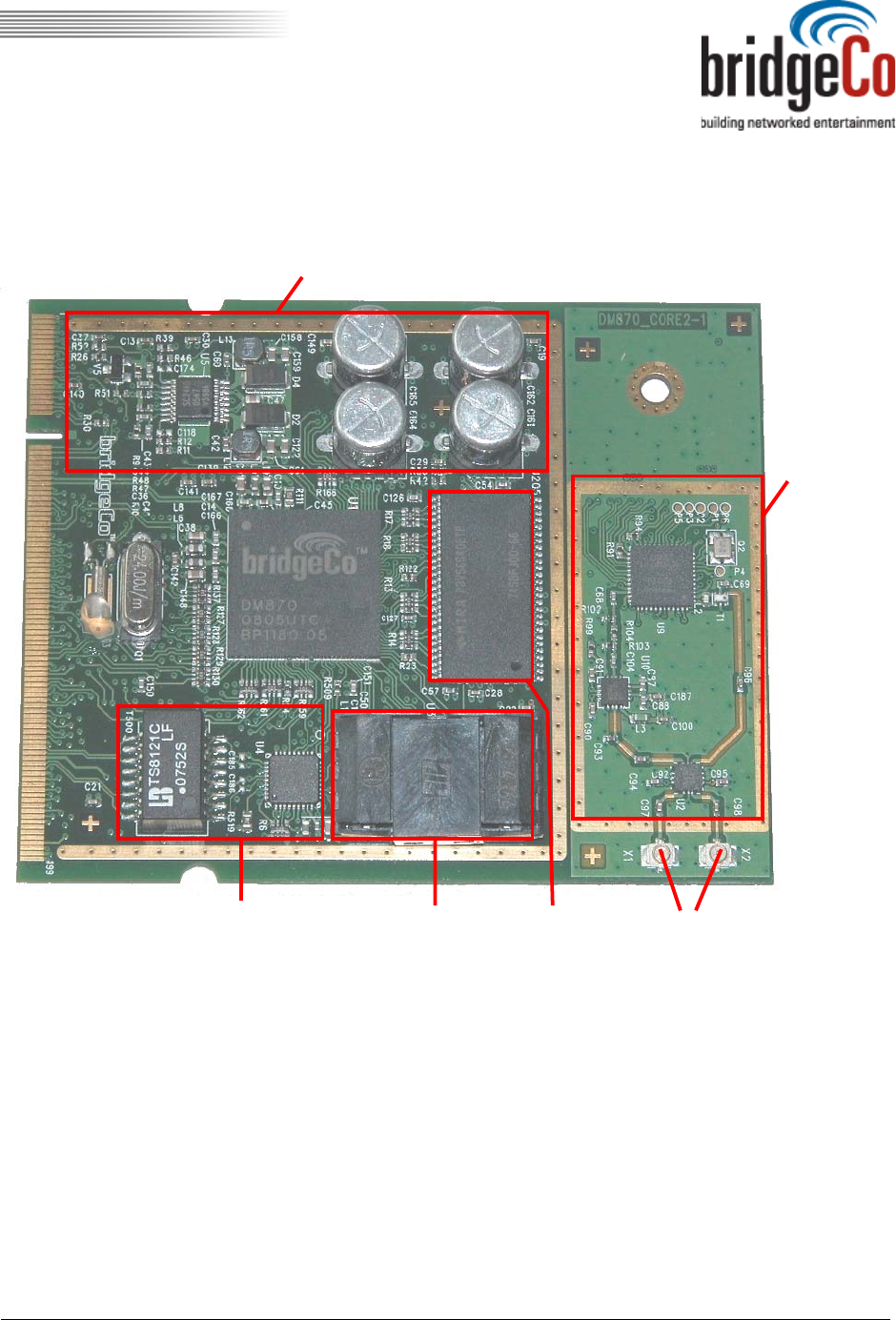
Hardware Guide DM870 Core-2
app_HwGuide_DM870-Core2.doc CONFIDENTIAL Version 1.2 – 04. Jun. 2008 page 2/5
BridgeCo AG – Ringstrasse 14 – CH-8600 Dübendorf – Tel: + 41 (44) 802 33 33 – Fax:+ 41 (44) 802 33 39 – info@bridgeco.net – www.bridgeco.com
Overview
switched power
supply
802.11b/g
front-end
antenna
connectors
SDRAM
FLASH
(optional socket)
ethernet
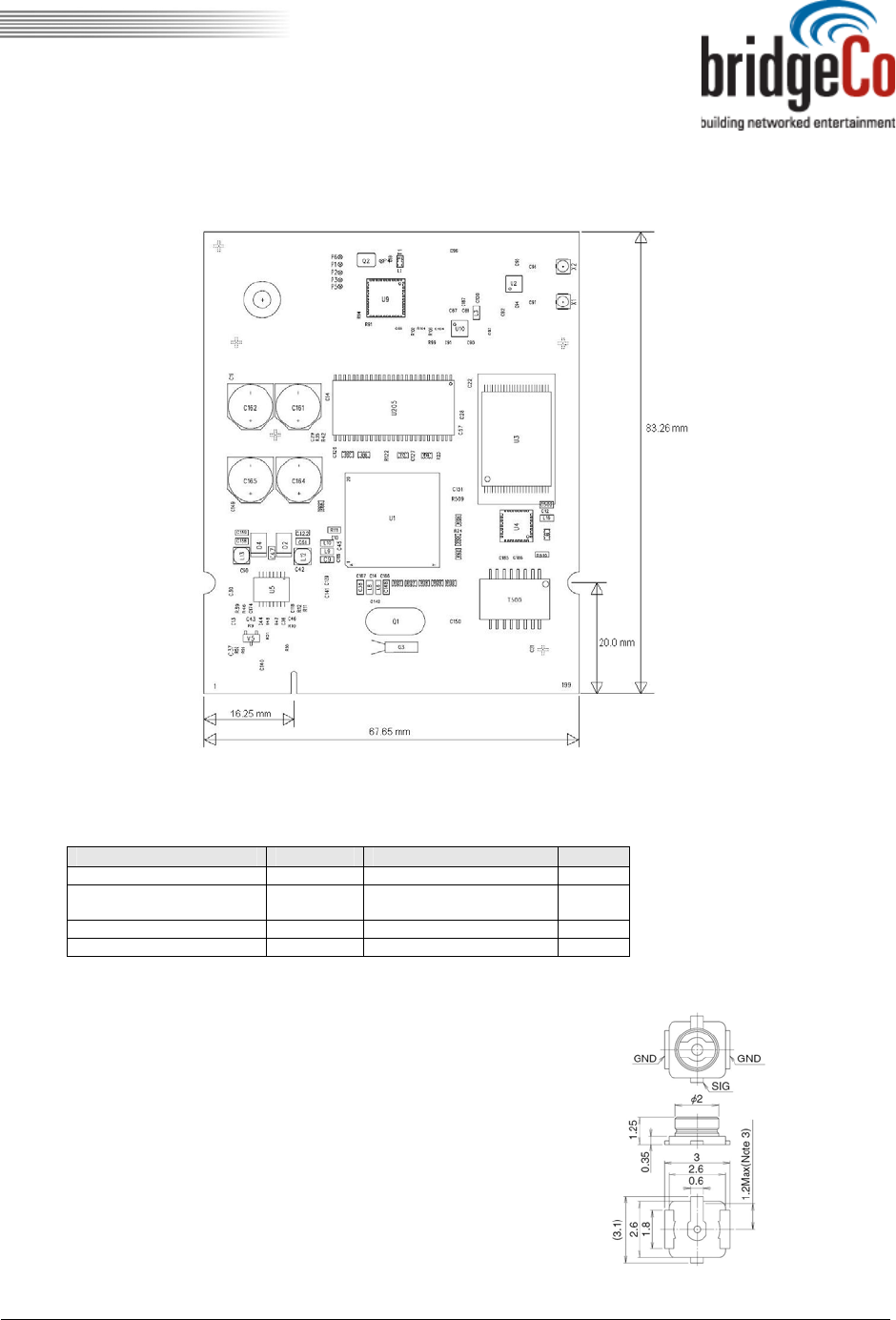
Hardware Guide DM870 Core-2
app_HwGuide_DM870-Core2.doc CONFIDENTIAL Version 1.2 – 04. Jun. 2008 page 3/5
BridgeCo AG – Ringstrasse 14 – CH-8600 Dübendorf – Tel: + 41 (44) 802 33 33 – Fax:+ 41 (44) 802 33 39 – info@bridgeco.net – www.bridgeco.com
Board Dimensions
Electrical Specifications
Parameter Symbol Specification (typ.) Units
Input Voltage VIN +5.0 ± 5% V
Power Consumption PIN reset < 0.4
WLAN mode < 2.5
W
W
Output Voltage VOUT +3.3 ± 5% V
Output Current IOUT max. 150 mA
Connectors
WLAN Antenna Connectors
Two coaxial antenna connectors are provided for antenna diversity
support.
The surface-mount receptable parts:
Hirose
U.FL-R-SMT (CL No. 331-0471-0)
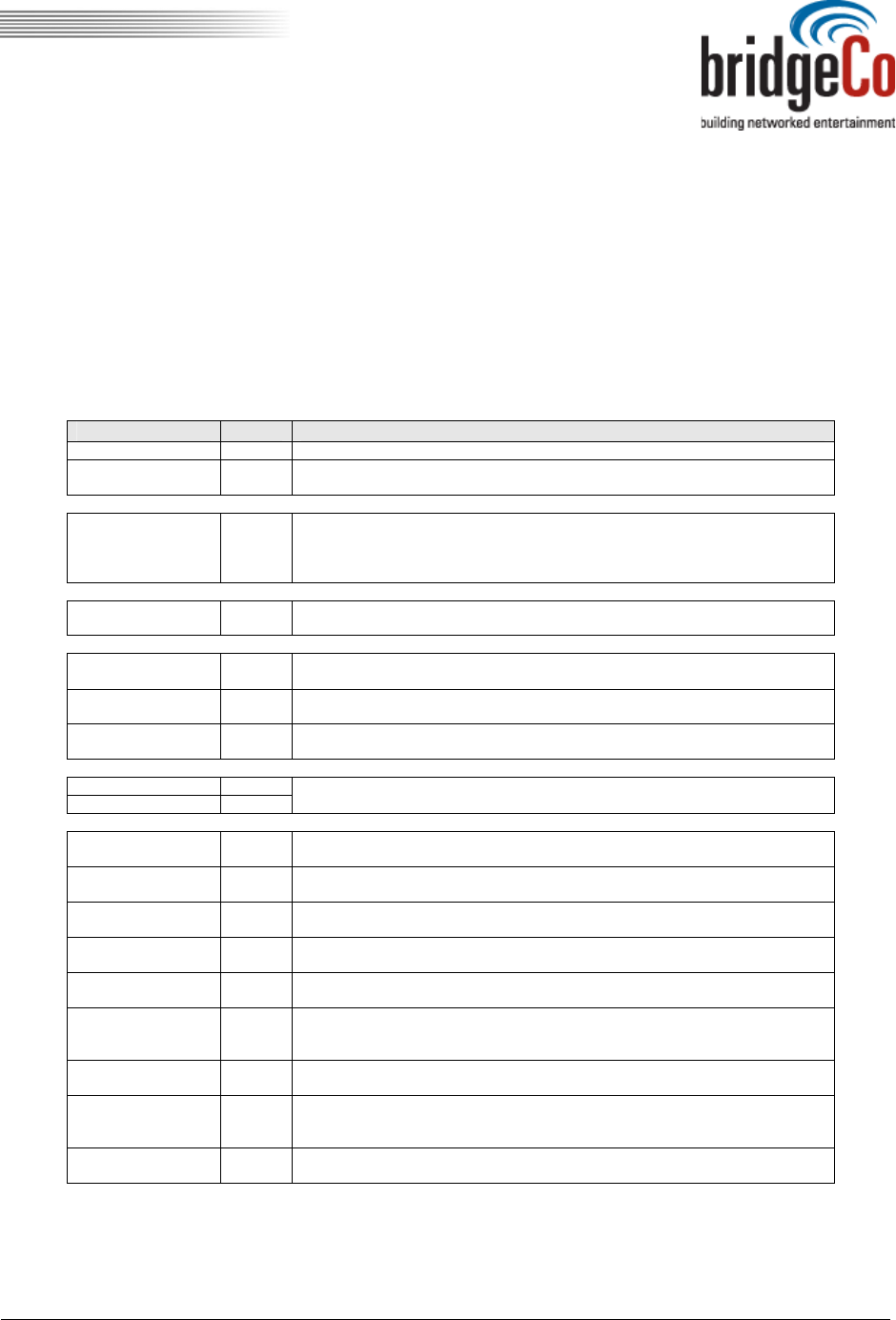
Hardware Guide DM870 Core-2
app_HwGuide_DM870-Core2.doc CONFIDENTIAL Version 1.2 – 04. Jun. 2008 page 4/5
BridgeCo AG – Ringstrasse 14 – CH-8600 Dübendorf – Tel: + 41 (44) 802 33 33 – Fax:+ 41 (44) 802 33 39 – info@bridgeco.net – www.bridgeco.com
SODIMM Module Connector
The DM870 Core-2 module uses a 200-pin SODIMM connector (1.8V type, 0.6 mm pitch, Jedec MO-224
outline) as an interface to the main board.
Example sockets: AMP 1565917-4
FCI 10033853-052FSLF
Molex 48213-1100
The pinout and signal names are shown on the next page. The following table provides an overview for
the most important control and interface signals:
Signal(s) Pin(s) Description
VIN 7,8,9,10 Input voltage; +5V ±5%
VOUT 27,28,
29,30
Stabilized +3.3V ±5% power supply for peripheral circuits; max. 150 mA
SPI_MOSI,
SPI_MISO,
SPI_CLK
SPI_NCS0, 1
11
13
15
12,14
SPI bus from DM870’s SPI controller.
The signals are shown in master-mode configuration, but they can be
configured for slave-mode by software.
RXD1, TXD1 23,25 3.3V logic level UART I/Os for the debug UART.
Provide external RS-232 transceiver to connect to a PC’s COM port.
NRESET 26 Low-active input to reset the module;
internal 10K pull-up
NPOWERDOWN 42 Low-active input to shut down the module’s power supply;
internal 15K pull-up
NPD_RF 62 Low-active input to shut down the power for the 802.11 Rf part;
internal 10K pull-up
AOUTL+/- 59,61
AOUTR+/- 63,65
Differential stereo output from PWM-DAC.
BIST activate 72 Low-active input to invoke the production BIST;
DM870-internal pull-up
TEST1 78 Low-active input to invoke DM870 test mode;
internal 10K pull-up
Factory Reset 81 High-active input to reset the configuration;
DM870-internal pull-down
IR input 83 Infrared sensor input. This is a Schmitt-Trigger input and can handle interrupt
inputs with slow slopes.
ETH_NRESET 85 Low-active reset for the on-board ethernet phy. This output is driven by the
DM870 and is not suited for other purpose.
SDA, SCL 87,89 I2C bus created by GPIO-14 and GPIO-13.
No internal pull-ups; if I2C is to be used, please add also the proper pull-up
resistors.
VPP 130 Voltage input to allow programming of DM870’s OTP. Leave unconnected for
normal operation.
FCLE, FALE 132,134 Boot mode inputs. The module uses a 4K7 pull-up on FCLE and a 4K7 pull-
down resistor to boot from the on-board NAND flash.
Leave unconnected for normal operation.
ETH_LED_ACT
ETH_LED_SPEED
160
162
3.3V push-pull outputs (max. ±12mA) to drive the ethernet LEDs.
A low-level indicates 100Mbps mode and activity respectively.
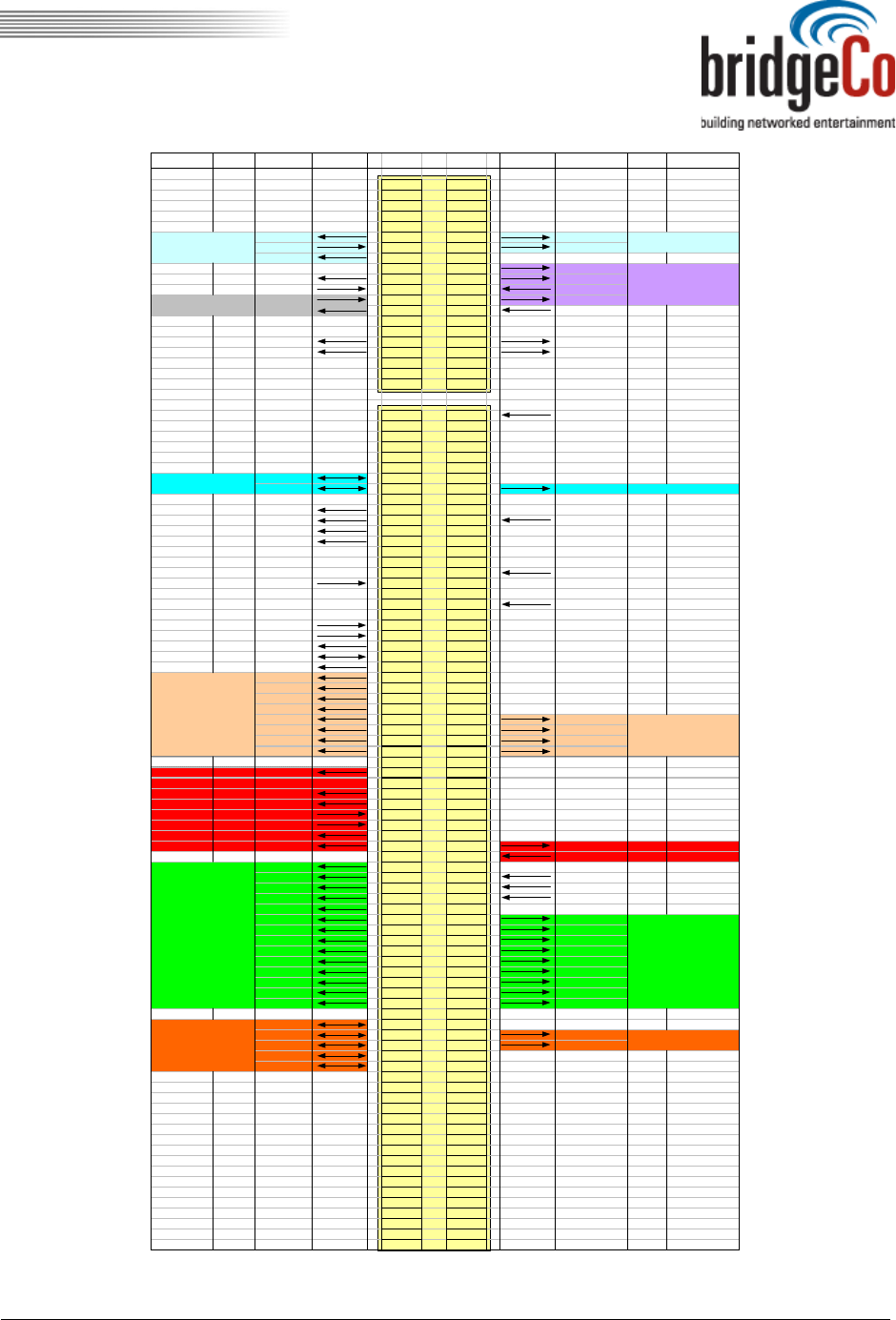
Hardware Guide DM870 Core-2
app_HwGuide_DM870-Core2.doc CONFIDENTIAL Version 1.2 – 04. Jun. 2008 page 5/5
BridgeCo AG – Ringstrasse 14 – CH-8600 Dübendorf – Tel: + 41 (44) 802 33 33 – Fax:+ 41 (44) 802 33 39 – info@bridgeco.net – www.bridgeco.com
Function GPIO Signal Power Power Signal GPIO Function
GND 12
GND
GND 34
GND
GND 56
GND
VIN (+5V) 78
VIN (+5V)
VIN (+5V) 910
VIN (+5V)
SPI_MOSI 11 12 SPI_NCS0
SPI_MISO 13 14 SPI_NCS1
SPI_CLK 15 16 GND
GND 17 18 TMS
TXD0 19 20 TCK
RXD0 21 22 TDI
RXD1 23 24 TDO
TXD1 25 26 NRESET
VOUT (+3.3V) 27 28 VOUT (+3.3V)
VOUT (+3.3V) 29 30 VOUT (+3.3V)
SPI_E_NCS GPIO-11 SSMD7 31 32 SSMD6 GPIO-10 SPI_E_CLK
SPI_E_SDI GPIO-09 SSMD5 33 34 SSMD4 GPIO-08 SPI_E_SDO
SSMD3 35 36 SSMD2
SSMD0 37 38 SSMD1
SSMCLK 39 40 GND
SSMCMD 41 42 NPOWERDOWN
SSMCP 43 44 GND
SSMWP 45 46 GND
47 48 GND
49 50 GND
GND 51 52 GND
USB D- 53 54 GND
USB D+ 55 56 USB_VBUS
GND 57 58
AOUT L+ 59 60 GND
AOUT L- 61 62 NPD_RF
AOUT R+ 63 64
AOUT R- 65 66 GND
GND 67 68 GND
69 70 3V3 (RTC)
GPIO-16 A23 71 72 NCS3 GPIO-17 BIST activate
IRQ input GPIO-18 A22 73 74 NCS2 GPIO-19
GND 75 76 GND
GPIO-06 PDOUT1 77 78 TEST1
GPIO-07 VCO1 79 80 GND
Factory reset GPIO-04 PDOUT0 81 82 GND
IR input GPIO-05 VCO0 83 84 GND
ETH NRESET GPIO-12 AV3CLK 85 86 GND
I2C SDA GPIO-14 AV3CTRL1 87 88 GND
I2C SCL GPIO-13 AV3CTRL0 89 90 GND
AV0CTRL2 91 92 GND
AV0CTRL1 93 94 GND
AV0CTRL0 95 96 GND
AV0CLK 97 98 GND
AV0DATA3 99 100 AV1DATA3
AV0DATA2 101 102 AV1DATA2
AV0DATA1 103 104 AV1DATA1
AV0DATA0 105 106 AV1DATA0
GND 107 108 GND
256FS ADDA_MCLK 109 110 GND
GND 111 112 GND
LRCK ADDA_LRCK 113 114 GND
SCLK ADDA_SCLK 115 116 GND
A/D data 1 AV2DATA3 117 118 GND
A/D data 0 AV2DATA2 119 120
D/A data 1 AV2DATA1 121 122
D/A data 0 AV2DATA0 123 124 AV4DATA1 SPDIF output
GND 125 126 AV4DATA0 SPDIF input
LCDCTRL3 127 128 GND
LCDCTRL2 129 130 VPP
LCDCTRL1 131 132 FCLE
LCDCTRL0 133 134 FALE
LCDCLK 135 136 GND
LCDD16 137 138 LCDD17
LCDD14 139 140 LCDD15
LCDD12 141 142 LCDD13
LCDD10 143 144 LCDD11
LCDD8 145 146 LCDD9
LCDD6 147 148 LCDD7
LCDD4 149 150 LCDD5
LCDD2 151 152 LCDD3
LCDD0 153 154 LCDD1
GND 155 156 GND
ETH_RX- 157 158 GND
ETH_RX+ 159 160 ETH_LED_ACT
ETH_CT 161 162 ETH_LED_SPEED
ETH_TX- 163 164 GND
ETH_TX+ 165 166 GND
GND 167 168 GND
GPIO-00 MIICRS 169 170
GPIO-01 MIICOL 171 172
GPIO-02 MIITXER 173 174
GPIO-03 MIITXCLK 175 176
MIITXD0 177 178
MIITXD1 179 180
MIIRXD0 181 182
MIIRXD1 183 184
GND 185 186 GND
187 188
189 190
191 192
GPIO-15 NWAIT 193 194
GND 195 196 GND
GND 197 198 GND
GND 199 200 GND
LCD Interface
Debug UART
SPI SPI
Ethernet Ethernet
USB USB
JTAG
Video Output
Video Output
LCD Interface
FEDERAL COMMUNICATIONS COMMISSION INTERFERENCE STATEMENT
This equipment has been tested and found to comply with the limits for a Class B digital
device, pursuant to Part 15 of the FCC Rules. These limits are designed to provide
reasonable protection against harmful interference in a residential installation. This
equipment generates, uses and can radiate radio frequency energy and, if not installed
and used in accordance with the instructions, may cause harmful interference to radio
communications. However, there is no guarantee that interference will not occur in a
particular installation. If this equipment does cause harmful interference to radio or
television reception, which can be determined by turning the equipment off and on, the
user is encouraged to try to correct the interference by one or more of the following
measures:
– Reorient or relocate the receiving antenna.
– Increase the separation between the equipment and receiver.
– Connect the equipment into an outlet on a circuit different from that to which the
receiver is connected.
– Consult the dealer or an experienced radio/TV technician for help.
CAUTION:
Any changes or modifications not expressly approved by the party responsible for
compliance could void the user's authority to operate the equipment.
RF exposure warning ·
This equipment must be installed and operated in accordance with provided instructions
and the antenna(s) used for this transmitter must be installed to provide a separation
distance of at least 20 cm from all persons and must not be co-located or operating in
conjunction with any other antenna or transmitter. End-users and installers must be
provide with antenna installation instructions and transmitter operating conditions for
satisfying RF exposure compliance.
This device complies with Part 15 of the FCC Rules. Operation is
subject to the following two conditions: (1) this device may not cause
harmful interference, and (2) this device must accept any interference
received, including interference that may cause undesired operation.
Canada Warning
"Industry Canada regulatory information Operation is subject to the following two conditions:
(1) this device may not cause interference, and (2) this device must accept any interference,
including interference that may cause undesired operation of the device. ""The user is
cautioned that this device should be used only as specified within this manual to meet RF
exposure requirements. Use of this device in a manner inconsistent with this manual could
lead to excessive RF exposure conditions."